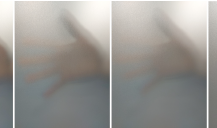
Transparent and translucent objects transmit part of the incident radiant flux permitting a viewer to see the background through them. Perceived transmittance and how the human visual system assigns transmittance to flat filters has been a topic of scholarly interest. However, these works have usually been limited to the role of filter’s optical properties. Readers may have noticed in their daily lives that objects close behind a frosted glass are discernible, but other objects even slightly further behind are virtually invisible. The reason for this lies in geometrical optics and has been mostly overlooked or taken for granted from the perceptual perspective. In this work, we investigated whether the distance between a translucent filter and a background affects perceived transmittance of the filter, or whether observers account for this distance and assign transmittance to the filters in a consistent manner. Furthermore, we explored whether the trend holds for broad range of materials. For this purpose, we created an image dataset where a broad range of real physical flat filters were photographed at different distances from the background. Afterward, we conducted a psychophysical experiment to explore the link between the object-to-background distance and perceived transmittance. We found that the results vary and depend on filter’s optical properties. While transmittance was judged consistently for some filters, for others it was highly underestimated when the background moved further away.
Rafique Ahmed, Davit Gigilashvili, "The Importance of Object-to-Background Distance when Evaluating Perceived Transmittance" in London Imaging Meeting, 2024, pp 47 - 51, https://doi.org/10.2352/lim.2024.5.1.11
 Find this author on Google Scholar
Find this author on Google Scholar Find this author on PubMed
Find this author on PubMed